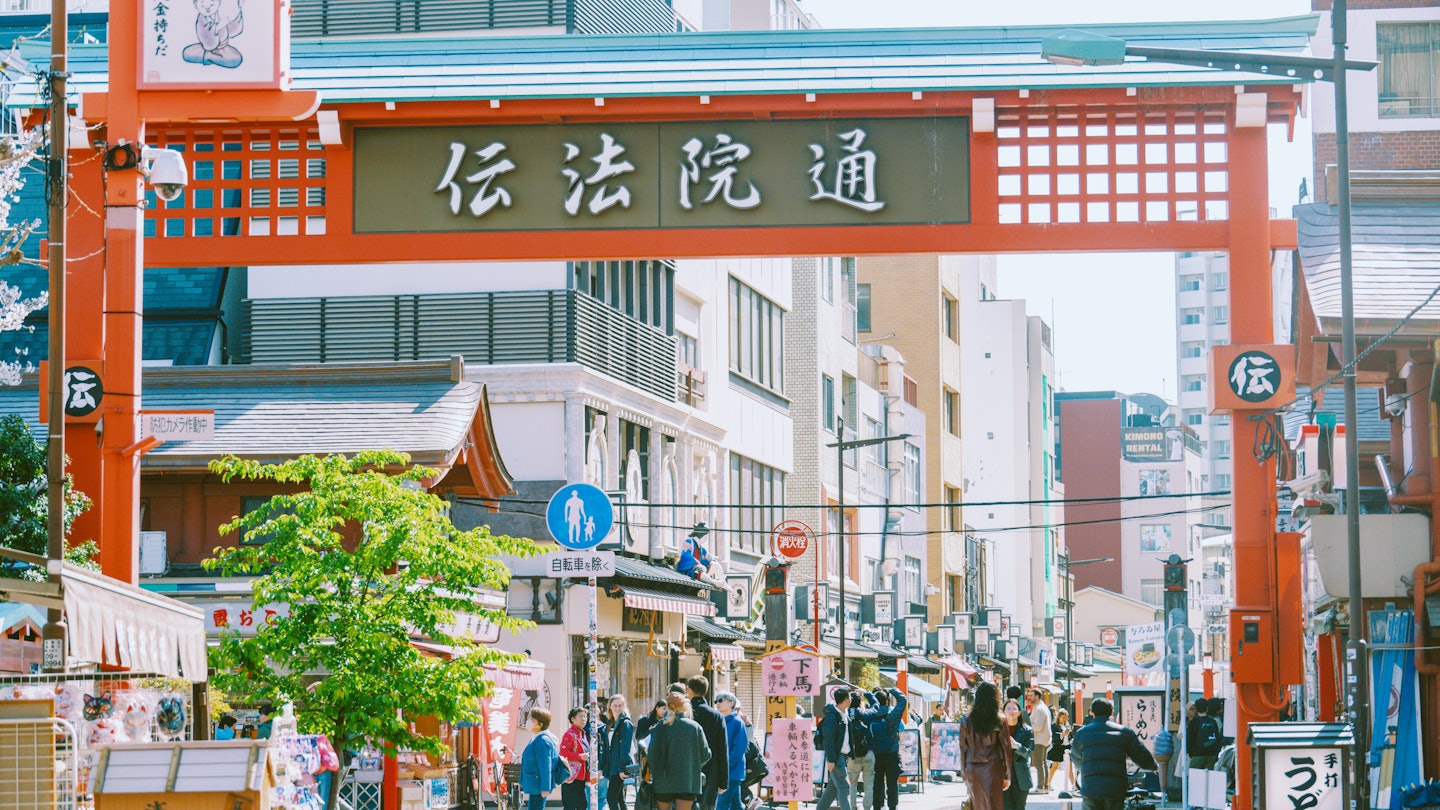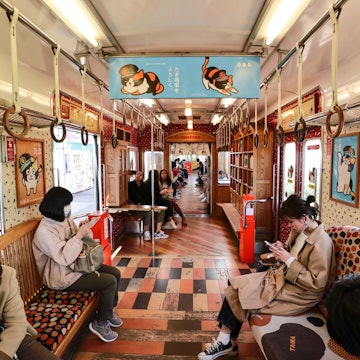

The gate at Denbōin-dori, a shopping street near Sensō-ji in Tokyo. Rintaro Kanemoto for Lonely Planet
Tokyo is the most populated city on earth, and its transport system moves millions of people around daily. Public transportation in Japan's capital is efficient, reliable, clean and generally safe, which makes getting around a breeze.
Of most use to travelers is the train and subway system, which is simple to navigate thanks to English signage and color-coded lines – even if some large stations, most notably Shinjuku, can be a maze for the uninitiated.
But despite unpredictable traffic patterns, buses tend to be equally punctual and can be useful for short journeys in quieter suburbs.
Tokyo’s relatively flat topography also means cycling and walking allow you to explore neighborhoods you’d otherwise not see if underground.
And if you want to combine your commute with sightseeing, take to the river on one of Tokyo’s beetle-like water buses, which travel between mainland Tokyo and the reclaimed islands of Tokyo Bay. This is everything you need to know about getting around Tokyo.

Using Tokyo's trains and subway system
Tokyo’s extensive rail network includes Japan Railways (JR) lines, a subway system and private commuter lines that depart in every direction for the suburbs like spokes on a wheel. Journeys that require transfers between lines run by different operators cost more than journeys that use a single operator’s lines.
Major transit hubs include Tokyo, Shinagawa, Shibuya, Shinjuku, Ikebukuro and Ueno stations – all connected via the JR Yamanote Line that circles the Imperial Palace, Tokyo’s central point.
Trains arrive and depart on time and are generally clean and pleasant, though they get uncomfortably crowded during rush hours and late at night. (For a short window in the morning and early evenings, many trains have women-only carriages.)
The city's trains stop running between midnight and 5am (give or take an hour, depending on the line) while many bars, clubs, karaoke rooms and izakaya (gastro pubs) remain in business until the wee hours or even 24/7. It's wise to check when your last train departs or be prepared to find another (more expensive) means of transport home.
The JR network covers the whole country and includes the Shinkansen (bullet train). In Tokyo, the above-ground Yamanote (loop) and the Chūō–Sōbu (central) lines are the most useful. Tickets start at ¥180 and go up depending on how far you travel.
Tokyo has 13 subway lines, nine of which are operated by Tokyo Metro and four by Toei. The lines are color-coded, making navigation fairly simple – although a transfer ticket is required to change between the two networks.
A Pasmo or Suica card makes this process seamless, but either way a journey involving more than one operator comes out costing slightly more. Fares depend on the distance traveled.

Transport passes
Referred to generally as IC cards or IC passes, prepaid rechargeable Suica and Pasmo cards work on all city trains, subways and buses. (You can also use passes purchased in other regions of Japan, such as the Icoca from western Japan or the Kitaka from Hokkaidō.)
Buy these from any touch-screen ticket vending machine in Tokyo (including those at Haneda and Narita airports); most have an English option and the cards are interchangeable. JR stations sell Suica, and subway and independent lines sell Pasmo.
Both require a ¥500 deposit, which is refunded (along with any remaining balance) when you return the pass to any ticket window. Passes can be topped up at any touch-screen ticket-vending machine (not just, for example, at JR stations for Suica passes) in increments of ¥1000.
iPhone users can use a digital IC card through their Apple Pay function and there are tourist-specific cards available at the airports. These have a much shorter expiration date than the regular cards – 28 days versus 10 years. If you still have an IC card from your last trip to Tokyo, it will work fine if it's less than 10 years old.
If you’re planning a packed day, you might consider getting an unlimited-ride ticket. The Tokyo Subway Ticket allows unlimited rides on both Tokyo Metro and Toei subway lines, with 24-hour, 48-hour and 72-hour options available.
This pass is only available to travelers on a tourist visa; you’ll need to determine whether the trains you plan to use will be largely JR or metro to get your money’s worth.
Using IC cards is simple: just run them over the card readers at the ticket gates upon entering and exiting. Fares for pass users are slightly less (a few yen per journey) than for paper ticket holders.

Riding the bus in Tokyo
Toei runs an extensive bus network in Tokyo, though it’s only more convenient than the subway when you’re in the outer suburbs or making short inner-city jaunts. The number 06 bus connects three popular cosmopolitan neighborhoods: Shibuya, Hiroo and Azabujuban.
Fares are ¥210 for adults and ¥110 for children; there are no transfer tickets. Pay by IC pass or deposit your fare into the box as you enter the bus – if your pass is out of credit, you can charge it at the front of the bus. (The word for “charge” is cha-ji.)
There’s also a change machine by the driver’s seat that accepts ¥1000 notes. Most buses have digital signs that switch between Japanese and English; otherwise, listen for your stop. Signal the bus to stop in advance of the approaching stop by pushing one of the buttons near your seat.
Japan is a global leader in hydrogen energy, one of the world’s cleanest energy sources, which emits only wastewater (even if some question the technology’s cost-effectiveness).
Hydrogen fuel cell buses have been in operation in Tokyo since March 2021, traveling primarily between Tokyo Station and the Tokyo Big Sight convention center in Ariake, while passing through the popular Yurakucho, Ginza and Tsukiji neighborhoods.
The local government is aiming to have more than 300 hydrogen buses in operation by 2030.

Tokyo's water bus
Tokyo’s water buses look like robotic beetles skimming across the placid waters of its eastern river networks.
Thanks to their glass-walled exteriors, they’re a great option for taking in the sights of Tokyo Bay while traveling between Asakusa and the likes of Odaiba, Toyosu and Hama-rikyū Gardens.
Journeys will cost between ¥1000 and ¥2600, depending on distance, and they are generally more comfortable than their terrestrial public transport counterparts.

Using Tokyo's taxis
Use a taxi in Tokyo after a late night out
Getting a taxi in Tokyo only makes economic sense for short distances or when in groups of four – unless you’re stranded during the lull in nightly train operations.
All cabs run by the meter, with fares starting at ¥500 for the first 2km (1.2 miles) and then rising by ¥100 for every 255m (836ft) you travel or for every 90 seconds spent in traffic.
When traveling longer distances, this starts to add up at a rather alarming rate, especially when you factor in the nighttime surcharge of 20% between 10pm and 5am, and potential highway tolls.
Drivers rarely speak English, though most taxis have navigation systems. Have your destination written down in Japanese – or, better yet, a business card with an address.
Most taxis now also take credit cards and IC passes; since the pandemic began many have introduced automated payment systems attached to screens on the back of the main passenger seat.
Train stations and hotels have designated taxi stands. In the absence of a stand, you can hail a cab from the street by standing on the curb and sticking your arm out.
Local tips for using cabs and finding addresses
Japanese cab doors are automatic, and many visitors find themselves struggling with self-opening doors. Be patient.
Once in the taxi, you’ll notice how difficult Tokyo’s streets are to navigate, even for locals. Only the biggest streets have official names, and they don’t figure into addresses. Instead, addresses are derived from districts, blocks and building numbers.
Central Tokyo is divided first into ku (wards – Tokyo has 23 of them), which in turn are divided into chō or machi (towns) and then into numbered districts called chōme. Subsequent numbers in an address refer to blocks within the chōme and buildings within each block.
Since it’s nearly impossible to find your destination using the address alone, smartphones with navigation apps have been a real boon.
Many restaurants and venues also have useful maps on their websites. If you get lost, police officers at kōban (police boxes) have maps and can help with directions, though few speak English.
At the very least, they should be able to steer you back to the nearest train station from where you can try again. Many businesses have also started using the What3Words app, which has divided the world into grids to help users pinpoint a specific location.
An Uber in Tokyo is not cheaper than a cab
Uber arrived in Tokyo in May 2018, though its boutique chauffeur service, Uber Black, dates back to 2015. The ride-share company has partnered with three local taxi operators to provide rides in Tokyo’s central business district and other busy areas.
Even though Tokyo strictly regulates ride-sharing apps, other competitors are entering the market, such as the city’s premier taxi app, Go.
Given Uber’s unpredictable availability and a pricing structure similar to that of street cabs, there are few occasions where using the app is merited.

Cycling in Tokyo
At first glance, Tokyo doesn’t seem like a bicycle-friendly city: dedicated lanes are almost nonexistent on major thoroughfares, cyclists often come up against pedestrian overpasses that need to be scaled (though a few have ramps for walking bikes up and down), and you’ll see no-parking signs for bicycles everywhere.
Despite all this, you’ll also see plenty of pedaling locals. This is because Tokyo is a largely flat city and much bike-friendlier if you’re cycling through city parks, in residential neighborhoods, along the river promenades near Tokyo Bay or around the maze of backstreets.
Docomo Cycle is a bike-sharing system with ports around the city, including some hostels.
Despite instructions in English, the system is a little complicated to use: you’ll need to download an app, register a credit card and have a wi-fi connection on the go to sync with the ports.

Renting a car in Tokyo
Considering the traffic, the confusing and often excruciatingly narrow roads, and the ridiculous cost of parking, it’s best not to use a car to get around Tokyo; even most Tokyoites don’t bother owning a vehicle.
Day trips can easily be done by public transport, though renting a car will expand your options and allow you to explore regions rarely visited by the touring masses.
For rentals, you will need an International Driving Permit, which must be arranged in your own country before you leave; certain conditions must be met (see the Japan Automobile Federation website for further information).
Rental companies with branches around the city include Nippon Rent-a-Car and Toyota Rent-a-Car.
Local tips for car rentals in Tokyo
Rental cars are generally affordable, especially when the cost is split among passengers. They are also economical with respect to gas mileage.
That said, highway tolls in Japan can be exorbitant. Driving to Osaka and back, for example, would cost over ¥29,000 in toll fees, mitigating some of the money saved on skipping the bullet train.
Also be sure to pay the extra fee for damage insurance. If you are in an accident, no matter how small, you must first call the police to record the incident before the vehicle is returned to the shop or you’ll risk incurring hair-raising financial penalties.
Rental operators are fairly unsympathetic to those who don’t follow these rules; it’s worth bringing a translator to go through the small print to avoid any such mishaps.
Accessible transportation in Tokyo
Tokyo is working hard to improve universal access – or bariafurī (“barrier-free”; バリアフリー) in Japanese. It’s estimated that at least 95% of Tokyo’s approximately 700 train stations have step-free facilities and accessible toilets, while 94% of buses are also wheelchair accessible.
Newer buildings have wheelchair-access ramps, more and more subway stations are introducing elevators (look for signs on the platform as not all exits have them), and yellow braille lines direct visually impaired passengers through major stations and guide them safely along platforms.
Train station staff will also help wheelchair users on and off trains with a temporary slope.
A fair number of hotels, from the higher end of midrange and up, offer a barrier-free room or two (be sure to book well in advance). Note that what constitutes “barrier-free” is not always consistent, so check the details carefully.
Larger attractions, department stores and shopping malls tend to have wheelchair-accessible restrooms. If you need a wheelchair (車いす; kuruma isu) while in Tokyo, hotel staff can help you rent one.
Accessible Japan is the best resource for accessible travel. It also produces an ebook with lots of detail.
















